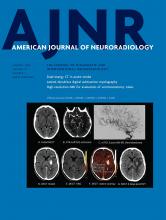Lateral Decubitus Digital Subtraction Myelography: Tips, Tricks, and Pitfalls

Abstract
SUMMARY: Digital subtraction myelography is a valuable diagnostic technique to detect the exact location of CSF leaks in the spine to facilitate appropriate diagnosis and treatment of spontaneous spinal CSF leaks. Digital subtraction myelography is an excellent diagnostic tool for assessment of various types of CSF leaks, and lateral decubitus digital subtraction myelography is increasingly being used to diagnose CSF-venous fistulas. Lateral decubitus digital subtraction myelography differs from typical CT and fluoroscopy-guided myelograms in many ways, including equipment, supplies, and injection and image-acquisition techniques. Operators should be familiar with techniques, common pitfalls, and artifacts to improve diagnostic yield and prevent nondiagnostic examinations.
ABBREVIATIONS:
- DSM
- digital subtraction myelography
- SIH
- spontaneous intracranial hypotension
- SSCSFL
- spontaneous spinal CSF leak
- © 2020 by American Journal of Neuroradiology
Indicates open access to non-subscribers at www.ajnr.org
In this issue
Jump to section
Related Articles
Cited By...
- Density and Time Characteristics of CSF-Venous Fistulas on CT Myelography in Patients with Spontaneous Intracranial Hypotension
- Safety and Technical Performance of Bilateral Decubitus CT Myelography Using Standard versus Increased Intrathecal Iodinated Contrast Volume
- {beta}-Trace Protein as a Potential Biomarker for CSF-Venous Fistulas
- Introduction to Digital Subtraction Myelography for CSF-Venous Fistula Detection
- CT-Guided Epidural Contrast Injection for the Identification of Dural Defects
- Clinical and imaging outcomes of 100 patients with cerebrospinal fluid-venous fistulas treated by transvenous embolization
- Spinal CSF Leaks: The Neuroradiologist Transforming Care
- Direct comparison of digital subtraction myelography versus CT myelography in lateral decubitus position: evaluation of diagnostic yield for cerebrospinal fluid-venous fistulas
- Evaluation of MR Elastography as a Noninvasive Diagnostic Test for Spontaneous Intracranial Hypotension
- Identifying Patients with CSF-Venous Fistula Using Brain MRI: A Deep Learning Approach
- Lateral Decubitus Dynamic CT Myelography with Real-Time Bolus Tracking (dCTM-BT) for Evaluation of CSF-Venous Fistulas: Diagnostic Yield Stratified by Brain Imaging Findings
- Likelihood of Discovering a CSF Leak Based on Intracranial MRI Findings in Patients without a Spinal Longitudinal Extradural Collection: A New Probabilistic Scoring System
- Utility of Photon-Counting Detector CT Myelography for the Detection of CSF-Venous Fistulas
- Utility of Photon-Counting Detector CT Myelography for the Detection of CSF-Venous Fistulas
- Temporal Characteristics of CSF-Venous Fistulas on Digital Subtraction Myelography
- Conebeam CT as an Adjunct to Digital Subtraction Myelography for Detection of CSF-Venous Fistulas
- Sacral CSF-Venous Fistulas and Potential Imaging Techniques
- Resisted Inspiration: A New Technique to Aid in the Detection of CSF-Venous Fistulas
- Clinical and imaging outcomes of cerebrospinal fluid-venous fistula embolization
- Utility of Dual-Energy CT to Improve Diagnosis of CSF Leaks on CT Myelography following Lateral Decubitus Digital Subtraction Myelography with Negative Findings
- Spontaneous Spinal CSF Leaks Stratified by Age, Body Mass Index, and Spinal Level
- Same-Day Bilateral Decubitus CT Myelography for Detecting CSF-Venous Fistulas in Spontaneous Intracranial Hypotension
- A Novel Endovascular Therapy for CSF Hypotension Secondary to CSF-Venous Fistulas
- Diagnostic Yield of Lateral Decubitus Digital Subtraction Myelogram Stratified by Brain MRI Findings
- Decubitus CT Myelography for CSF-Venous Fistulas: A Procedural Approach
- Safety of Consecutive Bilateral Decubitus Digital Subtraction Myelography in Patients with Spontaneous Intracranial Hypotension and Occult CSF Leak
- Time to Resolution of Inadvertent Subdural Contrast Injection during a Myelogram: When Can the Study Be Reattempted?
This article has not yet been cited by articles in journals that are participating in Crossref Cited-by Linking.











